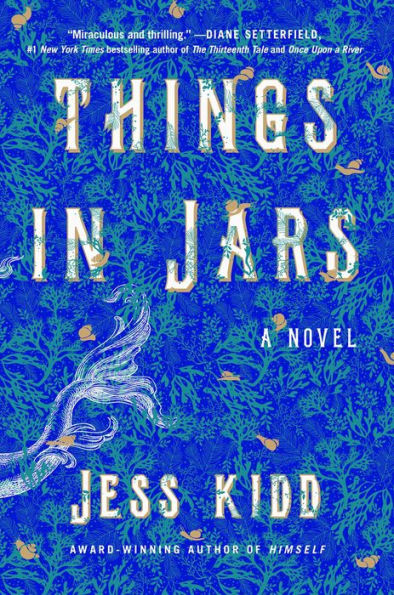“As pale as a grave grub she’s an eyeful.”
So begins Things in Jars, the third novel by beloved Londoner and author Jess Kidd. Just like it’s first sentence, Things in Jars is unique, complex, yet undeniably beautiful. Kidd’s prose is so daring—using stunning imagery and unpredictable, rare language—that I often found myself pausing while reading, taking time to bask in the beauty of a metaphor or pausing to reflect on a rhetorical question. And, like just like the author’s textured prose, Kidd has built a story that is winding, beautiful, and complex.
Things in Jars follows Bridie Devine, a renowned and savvy detective in 1860’s London, as she suddenly must uncover the kidnapping of Christabel Berwick, a strange child who is rumored to have supernatural powers. As Bridie sets off into the dark underbelly of Victorian London to rescue Christabel, she must confront an array of crooked characters as well as unearth disturbing truths about her own past. The plot is dark and gritty, but with an undeniable grain of optimism resting underneath. The novel constantly questions what it is to be human by blurring the lines between fantasy and reality.
Buy the Book


Things in Jars
The novel succeeds effortlessly on many fronts. Aside from the daring plot and Kidd’s stunning prose, what perhaps struck me most about the books was the unique cast of characters. Bridie herself is a masterclass of a protagonist—she’s bold and daring, but also plain fun and genuinely a joy to follow throughout her journeys. Aside from being a detective extraordinaire, Bridie is quick witted, a loyal friend, and a bit edgy in the best way, wearing a dagger strapped to her thigh and constantly smoking “Prudhoes Bronchial Balsam Blend” from her personal pipe. The ensemble cast of characters continue to flesh out the novel’s world. Ruby Doyle, for example, the ghost of a boxer who rises from his grave wearing only a top hat, unlaced boots, and underwear to traipse around London pursuing adventures, is a constant source of amusement throughout the plot. And Cora Butler, Bridie’s 7 foot tall housemaid, is a seemingly terrifying presence who ends up having a truly loyal heart. The goofy characters provide a much needed levity from the darker subject matters of the novel—the sweet romance between Bridie and Ruby and the blossoming friendships between the characters not only allow a break from the macabre subject matter, but also illustrate Kidd’s impressive range as a storyteller.
Perhaps the most prominent character in the novel is London itself. Kidd was brought up in London, and the city informs much of her writing. Her depiction of the city in Things in Jars is one of a dark and mysterious metropolis: The novel opens with a surreal storm, as the Thames rises from torrential rain, flooding basements and overwhelming the London streets. What’s more, her portrayal effortlessly toes the line between historical fiction and a darker fantasy world. Between the recurring image of the ominous raven throughout the plot and the threat of characters constantly lurking in the shadows, the reader often questions whether Kidd has brought them into a mysterious past, a Poe-like fantasy, or some combination of the two.
But this is the genius of Jess Kidd’s work: she has mastered the art of literary balance. Elements of fact, fiction, hope, and despair are abundant in this novel, and each play a different yet significant role. Many have compared Kidd to the likes of Gabriel Garcia Marquez, noting both author’s inclination towards the lens of magical realism. In Things in Jars, magic is everywhere, but it somehow never makes the plot feel less real. In one scene, choral music is heard from the river, and Bridie comments that she cannot tell if it is being sung backwards or in a foreign language. In another, doctors perform public surgeries for paying audiences, and Bridie once even witnesses an anaesthetic-free amputation at St. Bart’s hospital. Despite the absurdity of both these situations, Kidd somehow manages to not only make these scenes feel not only at home in her story, but truly vital to the plot.
Aside from blending reality with the absurd, Kidd also manages to balance quite an array of emotions throughout the story. Despite the sweet romance and budding friendships in the book, Things in Jars is a story of intense cruelty. Christabel’s abduction is devastating to read, and more instances of violence prevail throughout the plot as babies are poisoned and patients are mutilated by their doctors. Death is also a theme blended throughout every facet of the plot as Bridie is a self-described “corpse reader,” and often, sweet scenes of romance and instances of violence are placed back to back. Somehow, however, this juxtaposition is never too jarring, as Bridie’s humanity and quest for good is the thread tying the plot together. Ultimately, Things in Jars is a story about how goodness can triumph over evil: in Victorian London, in a dark, twisted fantasy, and in the reality of the reader.’
Things in Jars is available from Atria Books.
Mary is a freelance writer covering culture, identity, sexual politics, and wellness. Her work has been featured in The Guardian, The Nation, Glamour, Teen Vogue, Bitch Media, Vice, Nylon, Allure, and other similar outlets. When she is not writing she can be found scheming, watching cartoons, or sending unnecessarily long emails. To see more of Mary’s work and adventures, follow her on Twitter.









